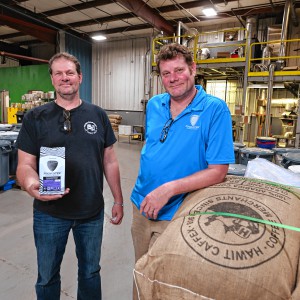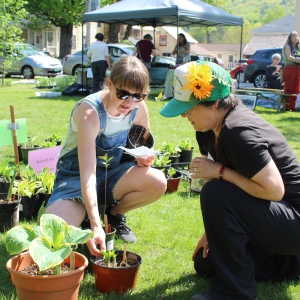Talking ‘regenerative grazing’ with an expert
| Published: 06-09-2023 2:57 PM |
In recent years, we have been told that beef and dairy cattle are in part responsible for global warming. They emit methane, mostly through belching.
Lynne Pledger of Shelburne Falls tells a different story. “People have gotten the message, which has complete validity, that beef production is a complete environmental disaster,” she told me in a recent interview.
“People have learned that lesson so it’s really a challenge for them to understand that it’s not producing cattle that’s the problem,” she said. “It’s the industrial mode of putting them in feed lots and raising grain to bring to them in the feed lots.”
In her book, “Grass-Fed Beef for a Post-Pandemic World” (Chelsea Green Publishing), she and her co-author Ridge Shinn argue that raising cattle properly not only offsets the pollution caused by methane but offers a way to make soil – literally the earth – healthier and more productive.
They use the term regenerative grazing. The practice involves not just feeding the cattle with only grass and hay but rotating them from pasture to pasture at certain points.
This allows microbes in the soil to thrive and to sequester carbon from the atmosphere. (The book – and the passionate Pledger – explain the process much better than I can!)
In the model espoused by Pledger and Shinn, cattle end their lives nearer to their original homes and in more humane ways than they do in industrial feed lots. Their lives are happier, and their meat is more nutritious.
“It’s not a how-to book for farmers. It’s more a why-to,” Pledger said of the book. She argued that regenerative grazing saves farmers money by eliminating the costs of grain, fertilizer, and shipping the cattle. It also enables cattle raisers to make their land healthier and more productive with less investment of capital.
Article continues after...
Yesterday's Most Read Articles
 Fogbuster Coffee Works, formerly Pierce Brothers, celebrating 30 years in business
Fogbuster Coffee Works, formerly Pierce Brothers, celebrating 30 years in business
 Real Estate Transactions: May 3, 2024
Real Estate Transactions: May 3, 2024
 Greenfield homicide victim to be memorialized in Pittsfield
Greenfield homicide victim to be memorialized in Pittsfield
 Softball: Franklin Tech pulls away from Hopkins, 8-3 (PHOTOS)
Softball: Franklin Tech pulls away from Hopkins, 8-3 (PHOTOS)
 As I See It: Between Israel and Palestine: Which side should we be on, and why?
As I See It: Between Israel and Palestine: Which side should we be on, and why?
 Bridge of Flowers in Shelburne Falls to open on plant sale day, May 11
Bridge of Flowers in Shelburne Falls to open on plant sale day, May 11
She said that she and Shinn have traveled around the country and the world meeting farmers who use this practice.
“Many of them did not get into this for environmental reasons. They were worried about losing the farm,” she stated.
Pledger and Shinn didn’t produce the book solely for farmers. They also hope to educate policymakers.
“Right now, our tax dollars are going to support subsidies for corn,” Pledger noted. “They are going to the commodity producers.”
This practice, she argues, encourages feeding cows with cheap, subsidized corn. “It’s not a natural food for cattle. I go into some detail as to how harmful it is to them as animals.”
It also fosters the big-beef system that went so amiss in the early months of the COVID-19 pandemic, when large, concentrated beef producers were forced to shut down.
In addition to getting rid of certain agricultural subsidies, Pledger believes that the federal government needs to change beef labeling. Currently, she said, “the grass-fed beef that’s in the big box stores is labeled ‘product of USA’.”
This labeling is misleading, she claims. Much of this beef is raised overseas, using practices that are less climate-friendly than the ones in her book, and the beef is only packaged in this country.
The label tries to fool consumers into believing that they are eating American-raised beef, she argues, saying, “People want to support farmers in the United States.”
Pledger believes that her book should be read not just by farmers and government officials but also by consumers, particularly those with a passion for the environment. She has been an environmentalist all her life.
She first became interested in the raising of cattle after her graduation from college, when she worked at Old Sturbridge Village.
“It was a big era for living history, where people were doing research on how people lived and worked,” she recalled. My research and program planning there focused on women’s work of the 18th and 19th centuries.
“Part of that women’s work was the dairy, milking the cows. Which I can do by the way. I can also make butter and cheese!” she laughed. “That got me into the topic of livestock and the history of livestock farming in the U.S.”
At Old Sturbridge Village she met Ridge Shinn. The two married, went into business together, and raised two children. They are now divorced, but they remain partners in writing and in their commitment to the environment.
Over the years, Pledger has become increasingly interested in the science of carbon sequestration. Her book draws on studies, particularly since the 1990s, that document the benefits of regenerative grazing.
“People can’t agree on the best way to do carbon sequestration,” she observed. “They tend to be attracted to these very high-tech, very high-risk solutions.”
“Look at these other benefits you get from farming in this way. You get nutrient-dense food, protection from floods, et cetera. It’s a win-win. There’s no downside to it... It’s more common sense.”
Lynne Pledger described Wheel-View Farm in Shelburne as a prime example of successful regenerative grazing.
“Grass Fed Beef for a Post-Pandemic World” is available at Boswell’s Books in Shelburne Falls, the World Eye Bookshop in Greenfield, and the Broadside Bookshop in Northampton. It may also be ordered from any bookseller.
Tinky Weisblat is an award-winning author and singer. Her most recent book is “Pot Luck: Random Acts of Cooking.” Visit her website, TinkyCooks.com.

 The house that therapy built: Multimedia artist Lisa Winter to display “My House” at the Wendell Meetinghouse this Sunday
The house that therapy built: Multimedia artist Lisa Winter to display “My House” at the Wendell Meetinghouse this Sunday Fun Fest returns to Turners Falls: Música Franklin hosts 6th annual family-friendly, free event, May 11
Fun Fest returns to Turners Falls: Música Franklin hosts 6th annual family-friendly, free event, May 11 Valley Bounty: Delivering local food onto students’ plates: Marty’s Local connects farms to businesses
Valley Bounty: Delivering local food onto students’ plates: Marty’s Local connects farms to businesses Let’s Talk Relationships: Breaking up is hard to do: These tools can help it feel easier
Let’s Talk Relationships: Breaking up is hard to do: These tools can help it feel easier
